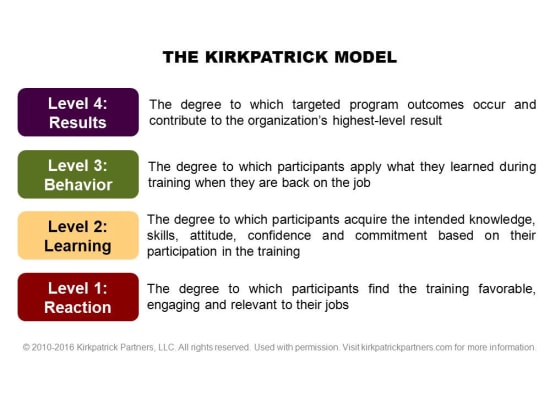Influencing on-the-job behavior for a learning initiative

“Evaluation is not an afterthought to training, but rather is meant to be integrated into the entire learning and development process. If you wait until after a program is designed, developed, and delivered to consider what value it is supposed to provide to the organization and how you will evaluate it, there is little chance of the program having much value.”
― James D. Kirkpatrick, co-author, Kirkpatrick Four Levels® of Training Evaluation
Evaluation in learning and development is often mistakenly used only at the last stage after a program is implemented. However, to achieve training effectiveness, improve job performance and maximize organizational results, evaluation must be integrated into the entire learning and development process. And importantly, it should be leveraged to assess whether or not learning is being applied on the job.
After a training program, how can learning professionals, managers and learners make sure that behavior changes on the job? This is what Kirkpatrick Levels 3 and 4 focus on. Level 3 of the model is Behavior, level 4 is Results.

Here are a few tactics that all professionals can implement in their own organizations to influence on-the-job behavior for a program or initiative:
Keep the end in mind
Defining the end goal for any learning initiative is necessary to set the right foundation for what you wish to achieve. To ensure that learning moves in the right direction, begin by establishing the highest level result for your organization. Then, define how the training or initiative will contribute to accomplishing those results by focusing on the 'ROE'.
ROE, or Return on Expectations, signifies what a successful training initiative delivers to key business stakeholders, demonstrating the degree to which their expectations have been satisfied. It should be discussed with the business before building a training program. After a deep analysis of the business need, understand what the business aims to achieve and not just what it wishes to eliminate with the proposed training intervention.
Support on the job application
To effectively execute the third level of the Kirkpatrick Model, tactical bridges have to be built with the line managers and supervisors, as they are the ones involved with the participants in their entire learning and performance journey. They have a key role in implementing the Required Drivers: processes and systems that reinforce, monitor, encourage and reward performance of critical behaviors on the job. For example, praising the employee if you see him/her applying a newly learned behavior at work.
Coaching, mentoring, and monetary benefits like pay for performance, also prove to be useful at this stage. Through Required Drivers, learners get support in applying the learnings on the job and are able to imbibe those behaviors in their daily practice. However, managers and supervisors must be given proper guidance by the learning professionals on how they can leverage these drivers. They should be given a handbook or be told what behaviors and actions they should look forward to monitoring and supporting.
Monitor progress towards results
Moving on from the behavior stage, the focus now shifts on the results stage, where managers and supervisors should track progress towards key milestones. While planning the initiative, 'Leading Indicators' should be identified.
These are defined as short-term observations and measurements that suggest that critical behaviors are on track to create a positive impact on desired results.
For instance, after delivering a training program on communication, managers can survey customers to gauge if they are satisfied with the emails they are receiving. Additionally, they could see if the number of escalations related to communication challenges has reduced. Short-term indicators like these help the leaders to monitor whether the learning and performance initiative has contributed to the end in mind or not.
In the end, it is not only important to ensure that the learning and performance goals are met, but also to identify the performance gaps, and the challenges that learners might be facing in applying the behavior on the job. These concepts in the New World Kirkpatrick Model can be used to help them guide through the learning and performance journey and help them reach the final destination of increased performance and optimal organizational results.
(The article is based on a webcast by People Matters and C2C-OD, on the topic, ‘Getting to Kirkpatrick® Levels 3&4.’)















